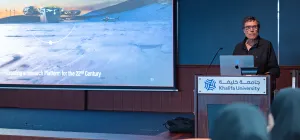Southbound

The Princess Elisabeth Antarctica station (PEA) is up and running for the 2021-2022 season!
After a quarantine in Cape Town and the usual PCR tests to punctuate our days, the Belgian Antarctic Research Expedition or BELARE (which rhymes with “volare”) departed for Antarctica on November 2nd. It was early in the morning when we left our hotel, and the sun was rising behind Eagle’s Nest, the mini peak next to Houtkapperspoort, where we were staying. There were 14 of us to take the Ilyushin. All of the expedition members for this first flight were crew members, tasked to open up the Princess Elisabeth Antarctica Station and to deal with any technical issues before the arrival of the scientists.
This is another COVID year. We hoped there wont be any more, because it really messes things up and means that you end up spending much longer in Cape Town, and have to factor this quarantine into planning.
The Expedition Leader is Alain Hubert. There is also systems team Benoît, Timothée and Nicolas; the doctor, Barbara; the Water Loop guys Bernard and Paul; the building maintenance and construction team, young Tom and French Thomas; the cook, another French Thomas; the Vehicle Ops team Pierre, Tim, and Yann; and Jacques, the snow machine operator from Québec. Nicknames will soon become essential….
Arriving on an Ilyushin Il-76 at the airfield of Novolazarevskaya Station (Novo Air Base) the team is rapidly shuttled towards the DC-3 feeder flight with their baggage. The journey to PEA is 450km, and it takes about one and a half hours. The DC3 isn’t so fast, but then you have to remember that it dates back to the early 1940s! We landed on the ungroomed airstrip around 8 pm. We had to leave most of the cargo at Novo to be brought to the station via a separate feeder flight the following day.
The BELARE team members used skidoos and sledges dug out of the containers next to the airstrip to cover the last 2 km to the Princess Elisabeth Antarctica.
The weather stayed clement, making for a gentle introduction to Antarctica for the newbies. There was no wind at Novo, which someone said was the exception. But it is now the Antarctic summer, so maybe it’s normal.
The crew arrived at the station and immediately set about with the first visual checks to identify any issues that might have occurred during the station’s long winter sleep. Temperatures inside had dropped to -25 °C during the winter.
The engineers run diagnostics to study any mechanical or electrical failures. Everything is an opportunity to learn and it is fascinating. Despite the extreme cold during the winter, there was no significant damage beyond a few extra deeply frozen food items. The backup generators were started up and ran the station for a short time, giving the power needed to dry out the technical parts of the station and restart the most critical station functions: water production, light, heating, and cooking. A guy’s gotta eat!
The gradual heating of the station back to normal temperatures was necessary to get the remaining electrical systems and batteries back up. In no time, the station was running on 100% renewables again.
Timothée, down in Antarctica for the first time, explains:
“As we continued to start up PEA’s systems (smart grid, water production and distribution, ventilation, water treatment, and communications), we also began the important annual task of clearing the snow from the station to free access to the garages and create a flat, ordered area in front of the station where we can park the scientific equipment, field containers and vehicles. This year we benefited from excellent weather conditions: lots of sun and little wind.”
All of the station’s essential systems had been successfully started by the end of the first week. The whole team is doing well and preparing for the coming weeks, which will be dedicated to carrying out general maintenance and improvements of the station and its systems before the arrival of the first scientists on December 7th.
The mood is good and it is really exciting to be in such an amazing place - not only in terms of the natural environment, but also in this station that looks like as it has just landed from an interstellar trip.
Beam me up, Scotty!
Download





















